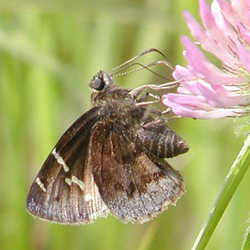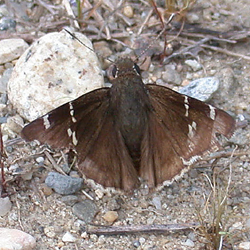Find a Butterfly
Southern Cloudywing
Thorybes bathyllus
Named
J. E. Smith, 1797

Identification
Wingspan 1 1/4 - 1 5/8". This species and its sibling, the Northern Cloudywing, are among the larger skippers found in Massachusetts. They may be distinguished from the larger duskywing species by the even dark brown coloration above, unpatterned except by a row of angular white spots, and the two loose bands of dark blotches on the hindwing beneath. The Southern Cloudywing differs from the Northern Cloudywing by its more prominently angular white spots on the forewing, the largest of which is hourglass-shaped, and its silvery-gray palpi (dark brown in Northern Cloudywing). Males lack a costal fold on the forewing.
Distribution
Southeastern Minnesota east across the southern Great Lakes states to southern New England and south to central Texas, the Gulf coast, and Florida. In New England, north to southernmost Vermont, New Hampshire, and Maine.
Status in Massachusetts
Uncommon to locally fairly common in eastern Massachusetts; apparently much rarer in western Massachusetts. This species has extended its range eastward since Scudder‘s time. He cited a handful of Massachusetts record, all from the Connecticut Valley. Forbes (1960) reported it "much commoner in Massachusetts in recent years than in the early 1900s." Atlas records show the species established in eastern Massachusetts, but practically nonexistant west of Worcester, with no Atlas records from the Connecticut Valley. Is the Southern Cloudywing truly rare in western Massachusetts? Given the overlap in flight periods and habitats between the Southern and Northern Cloudywings, as well as the many Atlas records throughout the state for the latter species, it is likely the recorded distribution is not the result of insufficient field work. The probability of systematic undercollection of one of two very similar species flying at almost the same time seems rather small. Maximum: 7 in Brewster (Barnstable Co.) on 5 June 1989 (B. Cassie).

Flight Period in Massachusetts
Mainly early June to mid-July. Extreme dates: 27 May ———— , North Andover (Essex Co.), S. Goldstein, and 14 July 1990, Sudbury (Middlesex Co.), R. Walton.
Larval Food Plants
A variety of legumes is reported, including Trailing Wild Bean (Strophostyles helvola), Hairy Bush Clover (Lespedeza hirta), Round-headed Bush Clover (L. capitata), Prostrate Tick Trefoil (Desmodium rotundifolium), Hoary Pea (Tephrosia, sp.), and Canadian Milk-Vetch (Astralagus canadensis).
Adult Food sources
Found nectaring on 4 species of flowering plants by atlas workers including Common Milkweed, Cat‘s-Ear, and clovers. Newly emerged males may also be found at wet soil along streams and trail edges.

Habitat
A variety of open and scrubby areas, including dry meadows, moist hayfields, powerline clearings, and upland barrens.
Life Cycle
EGG: Pale green; hemispherical and broad, with about 15 vertical ridges and cross striations. OVIPOSITION: Eggs laid singly on host plant leaves. LARVA: Mahogany brown, with paler lengthwise lines; head deeply cleft and black. CHRYSALIS: Dull greenish-brown and rather stout. OVERWINTERING STAGE: As pupae. The Southern Cloudywing is normally the latest to emerge of those butterflies which overwinter as pupae. Adults usually fly within a few feet of the ground. 27 May record not in data base; source??
Account Author
Stephen Goldstein



